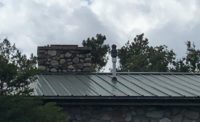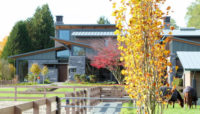Roll-forming and installing a tapered roof can be a complex and demanding type of job. Because of the nature of the design, there are usually more cuts and bends involved in making the panels. It also requires a certain degree of expertise to make the panels on site.
It takes more skill and experience to cut panels for a tapered roof than to run panels for a standard standing seam roof, but the result can be more visually appealing — and more profitable. And there is the pride factor in being able to install the tapered roof. It takes craftsmanship a step beyond the ordinary. Contractors who can complete a perfectly executed tapered roof with a multi-panel machine and their own manual dexterity are a notch above the norm and acknowledged as such by their peers.
The process of tapering a panel on both sides cannot be done with a fixed-position machine. If you’re a metal man facing the challenge of cutting your first tapered roof and you’re ambitious, here are some simple and helpful tips on how to make tapered panel on a multi-panel roll-forming machine with an adjustable width control.
To fashion tapered panels, follow these steps:
- First, remove left shear dies. (See Figure 1.)
- Mark a line on right side entry guide. You will need this guide to run all your panels required for the job. Move the right side entry guide a minimum of 35/8 inches left toward the middle of the machine. (See Figure 2.)
- Set left side entry guide to metal width. (See Figure 3.)
- Then crank the left side tooling to the preferred notch on the indicator. (See Figure 4.)
- Cut a length of sheet to the specification for the tapered roof and feed the material into the machine. (See Figure 5.)
- On the first panel to exit the machine, make sure that the rollers have not formed any bends on the right side. If there are bends from the right rollers, you must move the right entry further to the left. (See Figure 6.)
- Now, set the left shear dies to the panel. Make sure to check that your left side male leg is to specs according to the roll-former machine manual and/or the template. (See Figure 7.) You may want to run the panels a couple of inches longer to allow for cutting the ends square for installation. Once you have checked the panel dimensions and made the required adjustments, run the rest of your panels that are required for the job. You may want to run a few extra panels, just in case you make a mistake running the female leg.
- Now depending on the profile you are running, you must do the math to determine how much you must cut off on a taper. Add the total dimensions of the female leg. This is the amount that has to be added to what you want as a finished panel. Strike a chalk line down the panel, and try to make the cut as straight as possible. (See Figure 8.) The minimum size at the small end of the finished panel has to be 91/2 inches.
- Now, move the right side entry guide back to its original position, namely, the mark made in on the right side entry guide step at the outset of the project. (See Figure 9.)
- Move the left side entry guide and crank the tooling to the left so that the material is not being formed, but still making sure that the material rides on the guide bars. Finally, remove all the shear dies. (See Figure 10.)
- Now you are ready to run the female leg into the panel. This operation will take at least two people — one to guide the panel and the other to operate the machine. Take the panel and feed it back into the machine, holding it over to the right guide. It is very important that you run the engine at a low rpm — approximately 1000 rpm or less. You don’t want to go too fast because you have the other person guiding the material into the machine. Jog the material into the machine holding it to the right until it gets to at least the second drive roller. Wear gloves when handling the panels.
- Check the first panel’s female dimensions, making any required adjustments. Now, you’re ready to form your remaining panels.
With a little experience, your tapered metal roof design will achieve the stunning visual impact your customer has desired. And don’t hesitate to ask for help. Most manufacturer machine, engineering, and project management teams work closely with designers and contractors to address installation challenges, help reduce waste and guide the crafting of panels that are custom tapered for a perfect fit.













